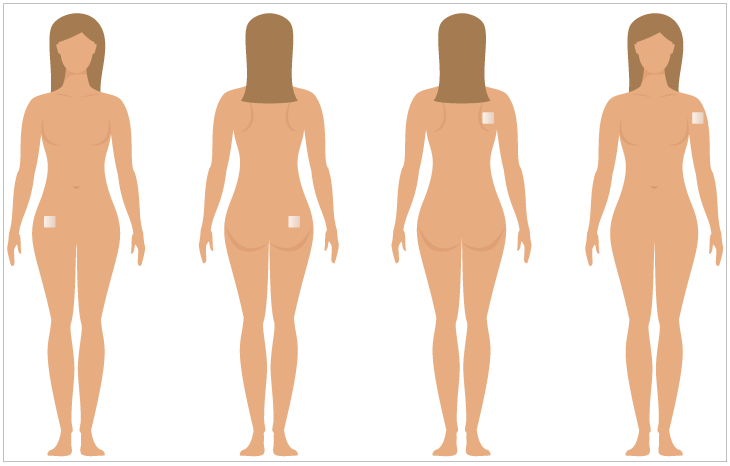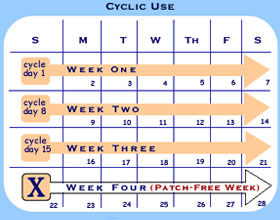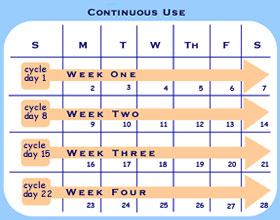Key Facts
- The patch is placed on the upper arm, lower stomach, buttocks, or back.
- Showering, swimming, exercising, and sweating should not loosen the patch.
- The patch should be changed every week.
- The patch does not protect against STIs.

The patch looks like a square Band-Aid (less than 2″ x 2″) and is worn on the skin. It contains hormone medicine like birth control pills, but the dose absorbed through the skin may be higher than birth control pills with 35ug of estrogen. In some studies, but not in others, there is a higher risk of blood clots. Make sure not to smoke if using the patch. When used correctly, the patch is as effective as birth control pills in preventing pregnancy. Just like birth control pills, your health care provider may also prescribe the patch for irregular periods, menstrual cramps, or endometriosis.
| Out of 100 women using the patch | |
| Average use: 7 women become pregnant | |
| Perfect use: 1 or less women become pregnant | |
How does the hormone patch work?
There are two different hormones (estrogen and progestin) in the patch. When you place the patch on your skin, the hormones are absorbed through your skin and enter your bloodstream. The hormones suppress your pituitary gland which stops your ovaries from releasing eggs. Without these eggs, pregnancy can’t happen. The patch also changes the lining of your uterus and the mucus in your cervix. The change in your cervical mucus makes it more difficult for sperm to reach the egg.
Is the patch as effective as the Pill in preventing pregnancy?
Yes, when used correctly. Health care providers and researchers studied over 3000 people and found that the patch was 91-99% effective in preventing pregnancy. However, the patch may be less effective for people who are overweight or obese, so check with your health care provider to see if the patch is right for you.
Before you start using the hormonal patch, it’s important to tell your health care provider if you:
- have ever been told that you or a family member have or has a blood disorder or clotting problems
- have ever had an allergic reaction to estrogen, progesterone, or any other medicine
- are taking any other hormonal medicine such as birth control pills, etc.
- are taking any dietary supplements or herbs including weight loss pills
- are overweight or obese
- are planning to have surgery in the near future
- have had any recent changes in your eyesight
Where (on my body) do I apply the patch?
The patch can be worn on the skin of your lower abdomen, buttocks, back, or upper arm. Wherever you decide to put it, you must leave it there for 7 days. You should change the location of the patch each week.

How do I put my patch on?
You can apply the patch like you would a Band-Aid. You must apply a new patch each week. Be sure that the spot where you have decided to wear your patch is clean and dry. Do not place the patch over irritated skin such as a rash or cut. Lotions on this area will cause the patch not to stick.
- With clean dry hands, open the foil package and remove the patch.
- Remove the clear plastic that covers the patch.
- While holding the nonstick side, firmly press the patch on your skin (abdomen/stomach, buttocks, upper back, or the outside part of your upper arm) for about 10 seconds.
- Check the edges of the patch to be sure that it is stuck firmly to your skin.
- Throw the clear plastic cover away.
When should I start wearing my patch?
This depends on what your doctor recommends for you. The patch is usually started on the 1st day of your menstrual cycle or the 1st Sunday after your period (the same way you would start birth control pills). Your health care provider may also tell you to start another day such as the day of your appointment.


How do I take my patch off?
- When you’re ready to change your patch or take it off, lift a corner of the square and gently pull it back until it comes away from your skin.
- Next, fold the patch in half, so the sticky part is folded on itself, then throw it away. (The reason for doing this is because there may be a little medicine still left on the patch).
- If there is any sticky adhesive left on your skin, you can remove it with a little bit of baby oil on a cotton ball.
- Be sure to put your new patch on a different skin area that is clean and dry. Lotions, oils, cream, tanning products, and makeup on the spot where you place your patch will prevent the patch from sticking.
Now that I’ve been using my patch… What if I’m more that 1 day late applying the patch on week 1?
If you forgot to restart your patch on time after your week off, apply it as soon as you remember. You MUST use another method of birth control such as condoms for at least 1 week. The first day that you apply your patch is considered Day 1 of your new patch cycle.
What if I forget to change my patch on week 2 or 3?
You can take the used patch off and apply a new patch right away if you are only 1-2 days late changing your patch. The next patch should be applied on your regular patch change day. Using a backup birth control method (such as condoms) for 7 days is recommended.
What if my patch falls off?
If you have noticed that your patch is off or almost off for less than 24 hours, try to put it back on or replace it with a new one. In research studies, less than 2% of patches came off and less than 3% of patches loosened.
If you don’t know how long your patch has been off or know that it’s been more than 24 hours, you’ll need to apply a new patch as soon as possible to prevent pregnancy. You must start a new 4-week cycle with a new patch change day. It’s very important to use another method of contraception for at least a week to prevent pregnancy.
What if my hormone patch loosens?
If your patch loosens, press down firmly along the edges of the patch with your finger for about 10 seconds. If your patch still doesn’t stick, remove, and apply a new patch.
What if my skin under the patch becomes irritated?
If you see that your skin around or under the patch is becoming irritated, take the patch off and place a new patch on another area. Throw the old patch away and leave the new patch in place until you normally change your patch. Never wear two patches at the same time. If you continue to experience irritation where you place the patch, tell your health care provider.
Can I still shower, take baths, exercise, and swim?
Yes. Showering, bathing, exercise, swimming, or even sweating shouldn’t loosen your hormone patch. If for some reason your patch does loosen or fall off, follow the steps listed above.
Will I get a menstrual period every month?
If you’re using the patch for 3 weeks with 1 week off, you should expect your period sometime during the 4th week of your patch cycle. This is the “patch free” week. If you’re using the patch continuously you most likely won’t have a period since you won’t have a “patch free” week. Some women may have spotting.
What if I forget to take my patch off on the 4th week?
Take your patch off as soon as you remember. Apply a new patch on your regular patch change day.
Are there any side effects with the patch?
Some adult and young women have reported side effects such as spotting or irregular bleeding, breast tenderness, headaches, nausea, cramps, and/or skin irritation or change in skin pigment (color) where the patch is worn. The patch contains the same medicine in birth control pills (the hormones estrogen and progestin), so it may not be safe for you if you have a history of certain medical problems. Not all teens can take hormonal medicine, especially if they’re at serious risk for blood clots, have high blood pressure, or have migraines with aura.
Routine check-ups and measurement of your blood pressure are important.
Our health guides are developed through a systematic, rigorous process to ensure accuracy, reliability, and trustworthiness. Written and reviewed by experienced healthcare clinicians from Boston Children's Hospital, a Harvard Medical School teaching hospital and consistently ranked as a top hospital by Newsweek and U.S. News & World Report, these guides combine clinical expertise, specialized knowledge, and evidence-based medicine. We also incorporate research and best practices from authoritative sources such as the CDC, NIH, PubMed, top medical journals, and UpToDate.com. Clinical specialists and subject matter experts review and edit each guide, reinforcing our commitment to high-quality, factual, scientifically accurate health information for young people.

